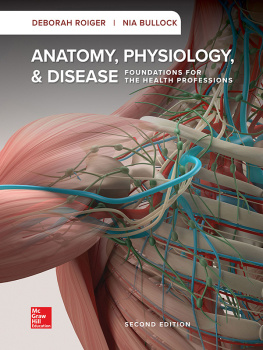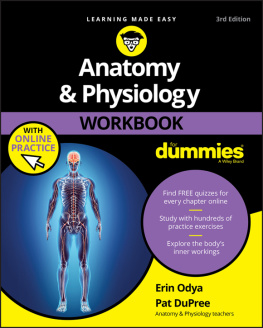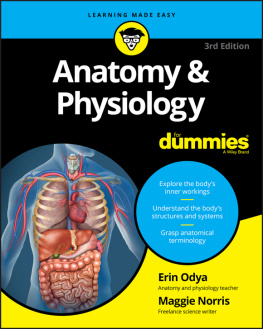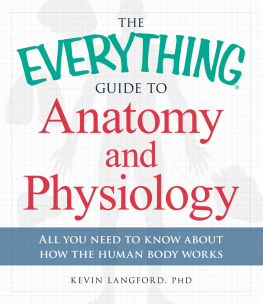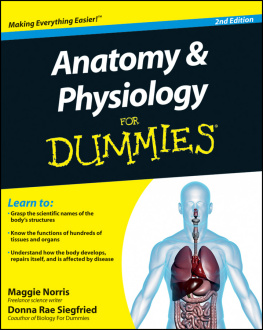An Easy Learning Guide to Anatomy and Physiology
Copyright , 2015 Bruce Forciea. All rights reserved worldwide.
2nd edition
About the Author
Bruce Forciea is a full-time anatomy and physiology instructor at Moraine Park Technical College. Besides developing courses, teaching, and producing digital media, he enjoys playing guitar and writing music. Dr. Forciea is trained as a chiropractor and attended Parker College of Chiropractic. Dr. Forciea is always working to make learning anatomy and physiology easy and fun.
Acknowledgements
Many thanks to Wikimedia Commons for making good anatomical images available, and to my students for helping to edit this book with their suggestions and comments.
For students
In hopes of easing their struggles.
ALL RIGHTS RESERVED
No part of this book may be reproduced or transmitted in any form whatsoever, electronic, or mechanical, including photocopying, recording, or by any informational storage or retrieval
system without express written, dated and signed permission from the author.
DISCLAIMER:
The information presented in this book represents the views of the publisher at the date of
publication. The publisher reserves the right to alter and update their opinions based on new conditions. This book is for informational purposes only. The author does not accept any
responsibilities for any liabilities resulting from the use of this information. Scientific information continuously progresses and changes. The author has done substantial work in order to ensure the information presented in this book is accurate, up to date, and within acceptable standards at the time of publication. The author is not responsible for errors or omissions, or for consequences from the application of the information contained in this book and makes no warranty, expressed or implied, with regard to the contents of this book.
Table of Contents
An Easy Learning Guide to Learning Anatomy and Physiology
You wouldn't think that learning anatomy and physiology would be so difficult, especially considering that you've lived in your own human body your whole life. As simple as your body may seem, it is considered one of the most complex structures in our universe. There are literally thousands of anatomical parts and complex systems in the human body. Learning about it can be a daunting task for even the most experienced student.
This book presents a layered approach to learning anatomy and physiology. Early on in my teaching career I found that many students became lost in the terminology and complexity of A&P. I also found that students learned better if they understood major concepts before getting into the details. Unfortunately (and understandably) a lot of textbooks are written in a way that presents each concept in detail. I can understand why this is so because each system does contain a lot of valuable information. However, I think that there is a difference with regard to presenting information and actually learning it.
This book is written to help you to learn the main concepts (what I call the Big Picture) before learning the details (what I call the nitty gritty). I will present each section by giving you the Big Picture concept. You really need to work to understand this first. Once you do you will begin to learn the details. I will present a good deal of details but not as many as a traditional 1000 plus page college textbook, so you may still need to consult a text. What you will get is an understanding of the basics of what you need to know in a traditional two-semester course in college anatomy and physiology.
I realized how this approach worked back in my student days when I took a rigorous gross anatomy class in professional school. This class included about fifteen hours of cadaver dissection per week and went on for two semesters. We were responsible for knowing everything we dissected including not only the major muscles, bones, nerves and organs, but also the extremely detailed blood and nerve supplies to muscles and organs.
I would return to my small apartment after class and create lists of anatomical structures in an attempt to memorize them by brute force. This was an exhausting way to learn and I did not by any means retain a lot of information beyond the exams. About a third of the way through the course I picked up my old A&P book, the one that I used early in my undergraduate studies. I went through the chapters and made my own notes summarizing each system and set of anatomical structures. This helped me immensely. Seeing and learning the big picture first really made a difference in my success.
I would always begin my anatomy study time by going over the big picture followed by examining the details. I carried this technique with me throughout my studies and still use it to this day. Now a good portion of what I do is to get students to learn the big picture before they learn the details.
This book is organized according to systems much like a traditional college level anatomy and physiology textbook. In fact you can and should use this book with your text. One suggestion is to read the section that corresponds to your studies in this book first, then proceed with your text for more details. This book won t cover all of the concepts and details that a traditional 1000+ page text will but it does cover a lot of material.
I personally use this book in each of my college level anatomy and physiology courses. Students find the book much easier to read than the traditional texts and say that it helps them to learn the concepts much faster. Many go through the courses without using a traditional text.
The important thing is to approach your study of anatomy and physiology with an open mind and not to get discouraged if you don t understand something right away. Sometimes concepts need to sink in. Also, the study of anatomy and physiology builds on information learned in earlier sections. You may need to frequently review earlier concepts. That s okay, I still review concepts too.
I sincerely wish you the best success in your study of anatomy and physiology and I am grateful to be of any help in the process. I hope you enjoy this book as much as I have enjoyed putting it together.
Visit my sites:
www.bruceforciea.com
www.easyanatomyandphysiology.com
Chapter 1
Body Basics
Before we delve into the details of the human body it s a good idea to get some basics under our belts. In this chapter we will learn some basic concepts and terminology that apply to anatomy and physiology. It shouldn't be too painful just remember to keep the big picture in mind.
First of all let s talk about what the words anatomy and physiology mean. Anatomy refers to the body parts (structure) while physiology refers to how they work (function). How parts are constructed relates to how they work.
Homeowhatsthis ??
One important concept in physiology is the concept of homeostasis or the ability of an organism to regulate variables in order to maintain stability. The human body exists in a state of balance. The right amount of hormones flow through our bloodstreams, our hearts beat just fast enough to provide oxygenated blood to our tissues, our lungs breath in the right amount of oxygen to keep us alive and so on. Our bodies maintain this state of balance by way of feedback mechanisms. There are thousands of these mechanisms that help to keep you alive. They work to regulate things like blood sugar, hormone levels, and your heart rate.
There are at least three parts to a homeostatic mechanism. There must be some sort of sensor that monitors a state or senses a change in that state. There must also be a control center that processes information about changes in the system. Finally, there must be an effector that enacts change on the system.
Next page


